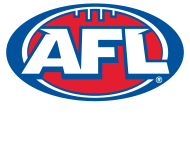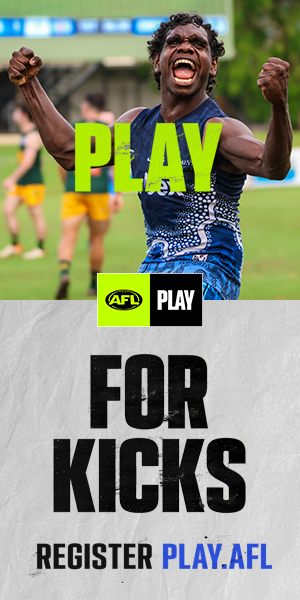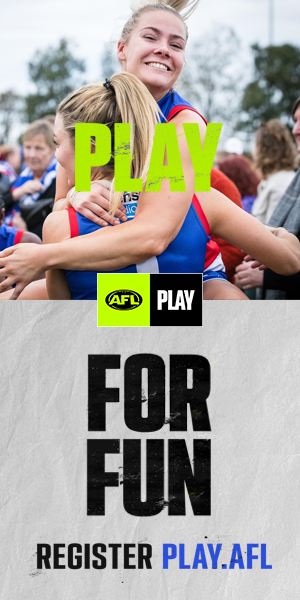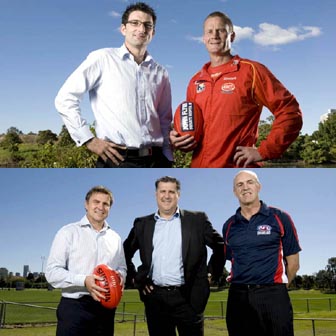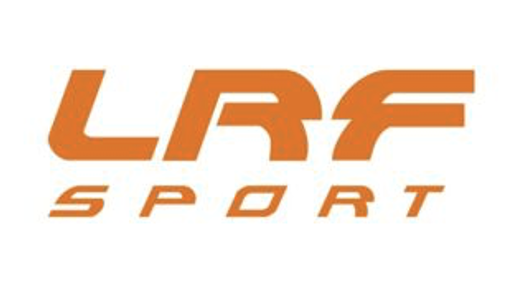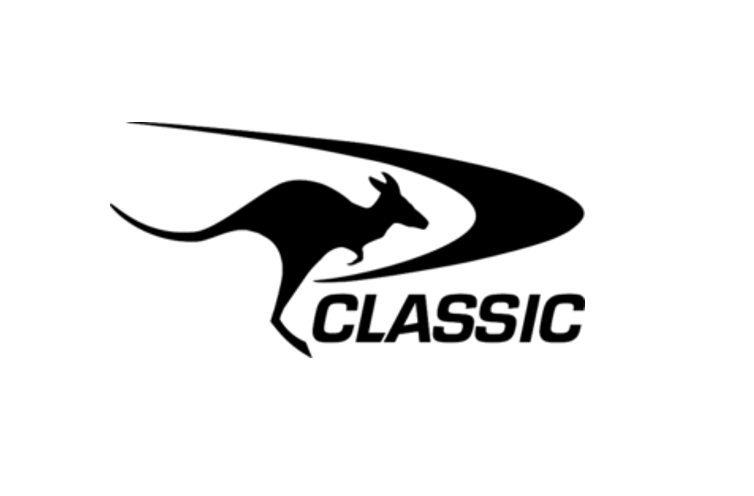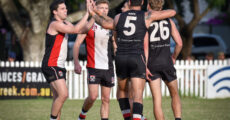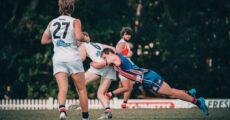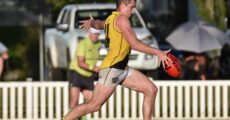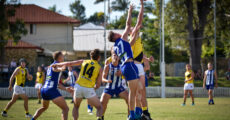Monday 30 August 2010
The birth of the Gold Coast Suns has had much to do with the tremendous groundwork laid by AFL Queensland officials at the grass roots level over the last decade. Mindful of that, the Suns will be an entity that embraces and reflects community values, fostering a sense of unity and pride for the people of the Gold Coast, reports PETER RYAN from the AFL Record.
Perhaps the Gold Coast image of our dreams does exist. A woolshed doubles as a gymnasium. A half-built stadium, with yellow steel frames, and blinding white stands, dominates the temporary offices next to what has become Gold Coast Football Club. The receptionist is named, most appropriately, Hope.
Yet it’s the standing surfboard carrying the club’s logo that brings the space alive. Ten minutes by car and the surf is sweeping swimmers off their legs.
Right now, the club is a name, an idea, still developing its brand, values and personnel, a point Suns CEO Travis Auld is well aware of.
“We have to define our reason for being,” says Auld, who learned his craft in 10 years under Peter Jackson at one of the game’s most famous clubs and brands, Essendon. “We play games of footy; everybody knows that, so why do we exist? We exist to foster a sense of unity, belonging and pride for the people of the Gold Coast. We don’t just exist to win games of footy.”
With the sky a bright blue and the sun caressing the back like a warm hand, you can imagine it being hard to talk football. But football is just one of the topics being spoken here. It’s clear this new club intends to reflect more than just the sun’s rays bouncing off the nearby Nerang River. In time, if managed properly, with respect, it aims to reflect the local football culture responsible for the emergence of the AFL’s 17th club, a culture essential to its future success.
It also aims to represent the community in the way those living on the Gold Coast want to be represented.
It’s why the word that comes up most often when chatting to Auld and coach Guy McKenna is responsibility. “We’ve got to prove there is substance above the sizzle,” Auld says.
AFL Queensland’s head office lives and dies on substance. Although it’s fair to say the office building has passed its use-by date – the Grogan Medal winners for the best and fairest in the QAFL listed on the honour board in reception stops at 2007 winner Todd Featherstone – the momentum those inside have tapped into shows no signs of slowing.
The move into new digs at the AFL Queensland Administration and Training Centre in Yeronga is keenly anticipated. “The strength of the AFL brand will be truly reflected by the headquarters we’ll be operating from,” AFL Queensland CEO Richard Griffiths says.
When Griffiths arrived from Melbourne in November of 1996 to lead the half a dozen staff that made up AFL Queensland and took up residence in the Clem Jones stand, years before the Gabba was redeveloped, he knew the job was going to be a challenge.
The offices lacked natural light and his budget reflected his surroundings: $980,000 to develop the game and $20,000 to run the state league. The bloke he appointed to run the state league, David ‘Sloppy’ Heilbron, would administer the competition from his Gold Coast cab while parked at Jupiters Casino waiting for a fare.
On the surface it did not look promising, but Griffiths got lucky. He had arrived in a state with a hidden but lively AFL culture, operating like an underground scene, a niche in the rugby-dominated market, populated by good people and some handy footballers.
Dean Warren, now the AFL’s national community development manager, had been part of that football niche since he arrived from Victoria’s western district aged 12 and settled with his family in Gympie, a country town 160km north of Brisbane. The town had one Australian Football and four rugby
league clubs.
“I had not even come across rugby league,” Warren says. “When the kids at school said at lunchtime, ‘Do you want to play footy?’ I thought that would be great. Then they started throwing the ball backwards and I thought, ‘What is going on here?’”
Warren need not have worried. Aged 17, he moved from his junior career with the Gympie Cats to Brisbane and played in the state league for Wilston Grange, which became Kedron Grange in 1990. By 1993 he had won a Grogan Medal.
The next year Warren was skipper as the team lost to Morningside in the Grand
Final, the two-point margin still causing him to wince. “It was a really good, strong competition,” he says of the state league back then.
It was a competition Gold Coast club Southport dominated.
Inside the bar in the Wally Fankhauser Stand at the Southport Sharks home ground, where Gold Coast has been playing home games in the VFL this year, you get a sense of that domination.
Framed newspaper articles celebrate flag after flag. An honour board for the Magpies Fishing Club and a boating chart to the right of the entrance serve as salient reminders of other activities on offer nearby, but it is a football club through and through.
A small photo of the bloodied face of former Footscray and North Melbourne star Gary Dempsey, who played in his only premiership with Southport in 1987 is most striking. His comment as he drank from his first premiership cup was, “The bloody thing leaks.”
It was into this environment that Queensland and New South Wales academies and talent manager Mark Browning, a 251-game veteran with South Melbourne/Sydney Swans from 1975-87, arrived to coach in 1994 after a stint in Hobart. Southport had won six premierships between 1983 (when it joined the state league) and 1992, so Browning arrived at the end of an era.
The playing list was transient, no recruiting was required and the players’ profile was low, but those involved were passionate, hard-working and smart. However, Browning could detect that the strength was dissipating as the Brisbane Lions took hold.
So when Browning became director of coaching at AFL Queensland in 1996 after his two-year stint with Southport, he set himself two targets: to get youngsters into the AFL and to regenerate and grow the state league. “When you go to watch local football now it is fantastic,” he says. “I am seeing 27-year-old blokes who have been through our representative programs at 14 and are still playing.”
He was also pleasantly surprised to find an education system that exposed children to all sports. Slowly but surely, he began to see the game develop a firm footprint. Trust was critical, relationships essential.
“We have never gone in with an arrogant attitude,” Browning says. “We want to be seen as part of the family. We are not the be all and end all.”
Browning remembers what his dad Keith, a former League footballer (53 games for South Melbourne from 1951-54) and country sales representative, had once told him: if you don’t get back to your clients often enough, you are going to lose the business. He made sure the development officers on the ground were seen and involved in football at the grassroots to maintain that connection.
“I think that was really important for us,” Browning says.
When the Lions won three successive flags (2001-03), the throwaway jibes occasionally heard from locals died. Participation grew and the Auskick development program gained respect.
Griffiths says the Lions’ success was pivotal to the game’s progress in the state: “As the flagship for the code up here, their wins added enormous credibility to the game and the increase in kids’ participation was enormous.”
Queensland schools no longer hung up the phone when someone from AFL Queensland, based at Coorparoo by then, rang to offer players to visit the school and conduct a clinic. In time, Warren would bristle when he heard the state described as a developing market. He could see the shift and preferred the word emerging.
“It’s gone from having a niche in the market to being a really strong player,” Warren says.
At Brisbane’s Stamford Hotel late in 2003, AFL chairman Ron Evans asked representatives of AFL Queensland the pertinent question: “What do we need to do to accelerate the development of the game in Queensland?”
The answer came back rapidly: “Start another team.” The seed for another AFL team in Queensland, this one based on the Gold Coast, was planted.
To ensure the AFL’s aim for a second Queensland club did not sink, the right people had to be involved. Football stalwart Alan ‘Doc’ Mackenzie and a good mix of the Gold Coast community, from the Gold Coast Bulletin’s Bob Gordon to Gold Coast City Council CEO Dale Dickson (who played 86 games for Melbourne and Brisbane between 1982-89)to lawyer John Witheriff, were on an advisory board, trying to develop a foundation for a new club. They wanted more than just a football team; they wanted an enterprise that would benefit the local community.
That is a mission everyone associated with Gold Coast uses as a mantra. “My focus early on has been to build the trust of the community before we ask anything of them,” Auld says.
Intent on listening, the club sat down with members and community leaders to understand what was important to the area. They developed five values that frame the new club: dependable, relentless, community (focused), bold and fresh.
“I’m not so presumptuous to walk in from Melbourne and say we know what you guys want,” Auld says. “So we spend a lot of time asking. We need to make sure we know exactly what they need because when it comes to us playing in round one next year, they need to see their footy club and think, ‘These guys listened. This does reflect the Gold Coast. It reflects everything we love about our city. We’re going to give it our support’.”
That debut AFL match is not far away. McKenna’s head lurches forward and his eyes widen in familiar style as he implores his team to dig deep in the last quarter of the Suns’ last home game in the VFL. Werribee has cut the margin from five goals to four points.
McKenna directs his attention to the 18-year-old from Cairns, Lewis Moss, who could hardly breath moments earlier as he came off the ground. “‘Mossy’, you’ve actually been really good and the body is screaming mate. You know what? Your teammates’ bodies are screaming as well. We need 30 minutes of effort,” McKenna says.
Young giant Charlie Dixon spreads his wings behind the group and the huddle tightens. The last address on home territory before the Suns hit the AFL in 2011 is nearing completion.
“Let’s get in, win that hard ball and keep our structure. We know we have to lower our eyes going inside 50, but we can’t do that unless we get our hands on the pill,” McKenna says.
In the forward pocket of the Fankhauser Oval, behind a brick Gold Coast Suns coach’s box that carries a ‘Visitors’ sign and pink cushioned chairs that serve as the interchange bench, stands 42-year-old Phil Amey from Reedy Creek. Amey is wearing a St George Illawarra jumper and a Gold Coast Suns cap. His connection to the local team has grown in the past two years as he has, in his words, watched the team go from being “scrawny teenagers to where they are now, able to present themselves so well on and off the field.” Amey is a member and watched the team play in the TAC Cup before graduating to the VFL. He says the club is full of good people.
The Suns win by a point. The players look at the boards carrying the words of the theme song as they huddle together and shout them out. Karmichael Hunt wears a relieved grin; captain Marc Lock a big smile. The roar you hear is one of a football club. Daniel Harris, a 149-game veteran with North Melbourne, sums up the vibe: “Once we get some big names, it’s going to go nuts I reckon, so it’s very exciting,” he says. “There is a lot of support up here for the AFL.”
What those who follow the game will have to support in football terms rests in McKenna’s hands. “I have no doubt it is going to be a very, very tough year,” he says when asked about on-field prospects in 2011. But he has been making decisions that will, he hopes, increase the team’s prospects. “We decided to go down the conditioning/culture path, rather than the training/game-sense and technical side of things,” McKenna says.
He figures that getting the bodies right will put young players more quickly into a position where they can dictate terms, rather than having them dictated to them.
Players are doing three weight sessions a week, even hitting the gymnasium the day before games. Alex Magin has gone from 62kg to 70kg and needs to put on another eight kilograms.
Skills, tactics and even opposition reviews are squeezed in to available time as the new club takes an innovative path. This year, Gold Coast analysed AFL teams when assessing which playing styles their upcoming VFL opponents were likely to use. McKenna knows his team will be punching above its weight in 2011, but believes the Suns have the off-field personnel and strategy to help them to do that. “It’s a unique situation and we are going to have a talented list of boys. It’s not about 1000 kicks, it’s about 1000 push-ups,” McKenna says.
The headline-grabbing signing of rugby league star Hunt was an endorsement for the code in Queensland. It also showed athletes there is an opportunity to stay home and play AFL. Griffiths is bullish about the positives the new recruit brings. “In this market, where we are competing against so many forces, (Hunt’s decision) will have so many benefits in a game development sense, in talent, in school participation and engaging with multicultural communities,” he says.
Engagement is critical, according to Auld. Everyone at the club is, he says, trying to ‘sell’ it. “The real benefit of having a bunch of 18-year-olds is that they have the courage to take the challenge on; they do not have any preconceived ideas about what is right or wrong and they are prepared to give 100 per cent of themselves,” he says. “Their enthusiasm has been beyond my expectations.”
Every player qualified for a bronze medal in surf life-saving in January after training at the Kurrawa club. The players banned themselves from the famous Cavell Avenue nightclub strip. The club identified the three most pertinent local social issues it could lend assistance to: youth homelessness, domestic violence and building social infrastructure through the northern corridors towards Brisbane.
The club is aware uncontracted players will be walking into an environment where staff and players understand the club’s place in the community.
Despite their AFL experience, recruits will be advised to act like rookies, establishing an understanding of what is happening before asserting themselves too much.
Harris knew immediately the right approach to take: “I needed to get the boys’ respect and trust first before I started barking instructions.” On field won’t be the only place where respect is gained. A local football fraternity will continue supporting the new club, provided the respect is mutual. Griffiths is sensing a strong future. “The club is doing so well from my perspective because it is genuinely a community-based club,” he says. “There won’t be huge expectation on the club next year in terms of wins and losses, but I don’t think that will matter because it will be a team the community will have embraced because the club embraced the community.”
Young player Taylor Hine waves from his car as he leaves club headquarters, his laconic, friendly gesture acknowledging the stranger’s presence one way of giving substance to the sizzle. Next year, he will be joined by a bunch of some
of the most talented youngsters in the country – as well as established AFL players – as the Suns move into another, exciting phase. “We’ll have to include extra (money) in players’ contracts around the time of 21sts, as there will be that many presents being bought at the one time,” jokes McKenna, as he imagines the future.
The traditional local community values this new AFL club has adopted will remain at its core. Staying connected while continuing to grow remains the huge challenge as the Suns hit prime-time. “People will judge this footy club on every interaction we have with them,” Auld says.
Pictures courtesy Slattery Media
